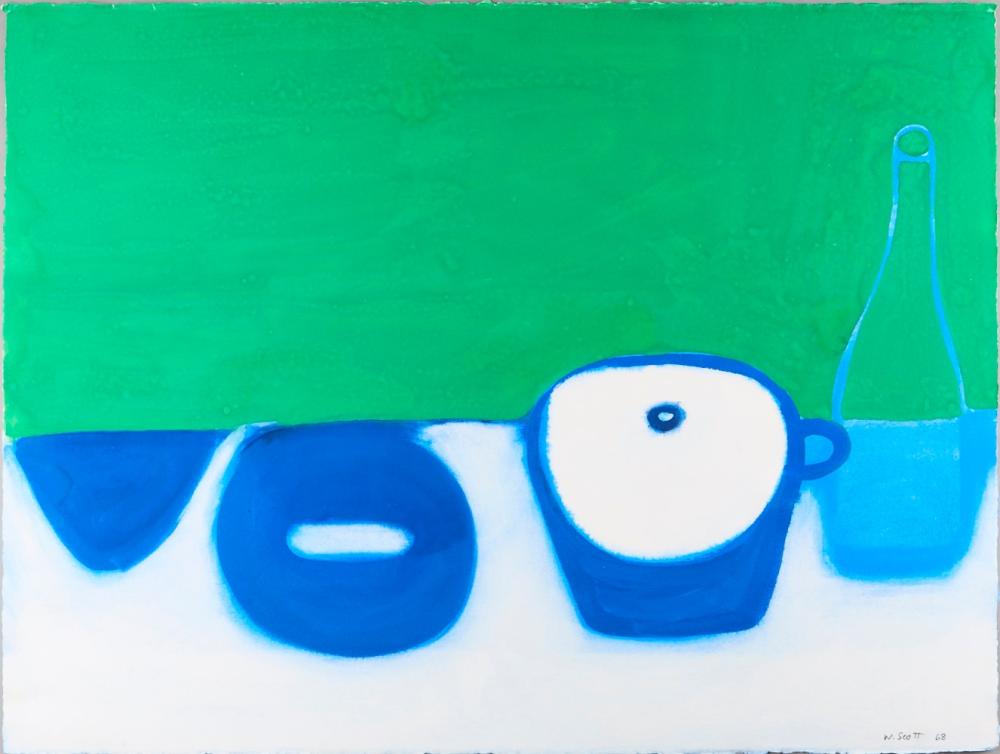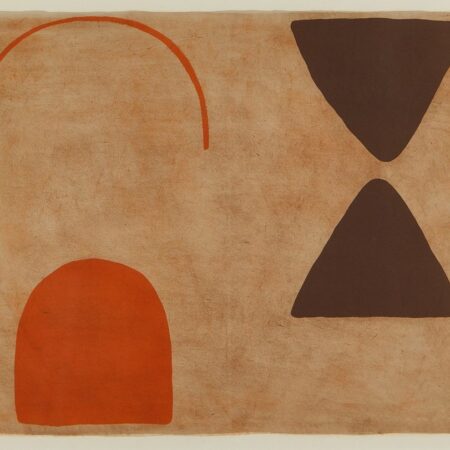
William Scott (1913-1989). Gouache on paper titled “Still Life, White and Blue on a Green Background.” Painting is signed along the lower left and dated ’68, and inscribed “Theme Blue and Green no. 1” in pencil along the verso. We would like to thank the William Scott Foundation for confirming the authenticity of this work, Archive Number 2346.
Provenance: Private Collection, Minnesota.
Biography: William Scott was born in Scotland in 1913. He shortly afterward moved to Northern Ireland with his family, where he began his artistic education with Kathleen Bridle, a local art teacher. He went on to study at the Belfast School of Art, and then later at the Royal Academy in London, where he initially studied sculpture before switching to painting.
After his graduation, he and his wife Mary Lucas, who he had met in art school, moved to France to open an art school with Geoffrey Nelson, a fellow painter. This school allowed Scott to pursue his artistic career in France while also focusing on teaching, a lifelong passion of his. During this time, Scott began to achieve artistic success, displaying his paintings–at this point, primarily still lifes–at the Paris Salon d’Automne.
At the start of World War II, Scott and Lucas moved back to Britain, where Scott enlisted in the army. In the army, Scott served in the Royal Engineers as a lithographic draftsman, putting his art skills to patriotic use. Following the war, Scott went to teach at the Bath Academy of Art. During this period, his success continued to grow, with multiple solo exhibitions, as did his network of other important artists. He was closely tied to the St. Ives Group of artists and also built friendships with abstract expressionists such as Mark Rothko and Willem de Kooning. It was during this period when Scott first began experimenting with abstraction in his works.
As he continued to gain success, he left his position at the Bath Academy of Art and painted full time. He represented the United Kingdom at the Venice Biennale and the São Paulo Biennale, where he won the prestigious Sanbra Purchase Prize. In the 1960s, Scott traveled the world with his art, exhibiting throughout Europe and Asia and doing a yearlong residency in Berlin. He lectured for the British Council in Australia, Mexico and India. His work also received great acclaim within Britain, with a retrospective exhibit at the Tate in 1972, which showed 135 of his works and many other major exhibitions. In addition, he was conferred honorary doctorates from Trinity College Dublin, Queen’s University Belfast, and the Royal College of Art in London, as well as being elected to the Royal Academy.
This piece is an important demonstration of the major art themes of Scott’s life, showing his still lifes on their slide into abstraction, containing both abstract and representational elements. The objects, while still recognizable, are flattened, and seem almost to hang off a horizon line rather than sit on a table. Scott’s subtlety in his blending of colors creates vibrance in an otherwise stiff composition, retaining the mood of his earlier still lifes.
Height: 22 3/4 in x width: 30 1/2 in
$27,000
